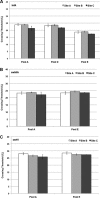Pooling nasopharyngeal/throat swab specimens to increase testing capacity for influenza viruses by PCR
- PMID: 22205820
- PMCID: PMC3295167
- DOI: 10.1128/JCM.05631-11
Pooling nasopharyngeal/throat swab specimens to increase testing capacity for influenza viruses by PCR
Abstract
Real-time PCR methodology can be applied to rapidly and accurately detect influenza viruses. During times of surge testing or enhanced pandemic surveillance, public health laboratories (PHLs) may experience overwhelming demand for testing, even while the prevalence of positive specimens remains low. To improve laboratory capacity and testing efficiency during surges, we evaluated whether nasopharyngeal (NP)/throat swab specimens can be pooled and tested for the presence of the 2009 H1N1 influenza virus without a reduction in sensitivity. Pools of 10 specimens were extracted and concentrated upon elution on the MagNA Pure LC instrument, and real-time PCR was performed on the Applied Biosystems 7500 Fast platform, using the CDC swine influenza virus real-time RT-PCR detection panel (rRT-PCR swine flu panel). Specimens in positive pools were singly re-extracted and retested by PCR to identify individual positive samples. Initial studies showed that spiking a pool of nine negative specimens (100 μl each) or 900 μl of virus transport medium with 100 μl of a positive clinical specimen caused no loss of sensitivity by rRT-PCR testing. Pools containing either multiple positive specimens or specimens positive for other respiratory viruses also showed no negative effect on crossing threshold (C(T)) values. To test the robustness of the pooling protocol, a panel of 50 blinded samples was sent to three PHLs and tested in five pools of 10. All PHLs correctly identified the positive specimens. This study demonstrates the feasibility of using a pooling strategy to increase capacity and conserve resources during surge testing and periods of enhanced influenza surveillance when the prevalence is low.
Figures

References
-
- Centers for Disease Control and Prevention 2009. Swine influenza A (H1N1) infection in two children—Southern California, March–April 2009. MMWR Morb. Mortal. Wkly. Rep. 58:400–402 - PubMed
-
- Centers for Disease Control and Prevention 2010. Update: influenza activity—United States, August 30, 2009–January 9, 2010. MMWR Morb. Mortal. Wkly. Rep. 59:38–43 - PubMed
Publication types
MeSH terms
Grants and funding
LinkOut - more resources
Full Text Sources
Other Literature Sources
Medical
Miscellaneous

